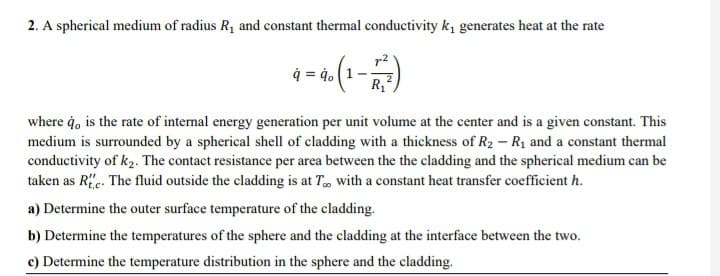2. A spherical medium of radius R₁ and constant thermal conductivity k₁ generates heat at the rate à = 40 (1 - 17²7) where q, is the rate of internal energy generation per unit volume at the center and is a given constant. This medium is surrounded by a spherical shell of cladding with a thickness of R₂ - R₁ and a constant thermal conductivity of k₂. The contact resistance per area between the the cladding and the spherical medium can be taken as Rt. The fluid outside the cladding is at T with a constant heat transfer coefficient h. a) Determine the outer surface temperature of the cladding. b) Determine the temperatures of the sphere and the cladding at the interface between the two. c) Determine the temperature distribution in the sphere and the cladding.
2. A spherical medium of radius R₁ and constant thermal conductivity k₁ generates heat at the rate à = 40 (1 - 17²7) where q, is the rate of internal energy generation per unit volume at the center and is a given constant. This medium is surrounded by a spherical shell of cladding with a thickness of R₂ - R₁ and a constant thermal conductivity of k₂. The contact resistance per area between the the cladding and the spherical medium can be taken as Rt. The fluid outside the cladding is at T with a constant heat transfer coefficient h. a) Determine the outer surface temperature of the cladding. b) Determine the temperatures of the sphere and the cladding at the interface between the two. c) Determine the temperature distribution in the sphere and the cladding.
Related questions
Question

Transcribed Image Text:2. A spherical medium of radius R, and constant thermal conductivity k, generates heat at the rate
4 = 4. (1-
where ġ, is the rate of internal energy generation per unit volume at the center and is a given constant. This
medium is surrounded by a spherical shell of cladding with a thickness of R2 - R1 and a constant thermal
conductivity of k2. The contact resistance per area between the the cladding and the spherical medium can be
taken as Re. The fluid outside the cladding is at T, with a constant heat transfer coefficient h.
a) Determine the outer surface temperature of the cladding.
b) Determine the temperatures of the sphere and the cladding at the interface between the two.
c) Determine the temperature distribution in the sphere and the cladding.
Expert Solution
This question has been solved!
Explore an expertly crafted, step-by-step solution for a thorough understanding of key concepts.
Step by step
Solved in 2 steps
